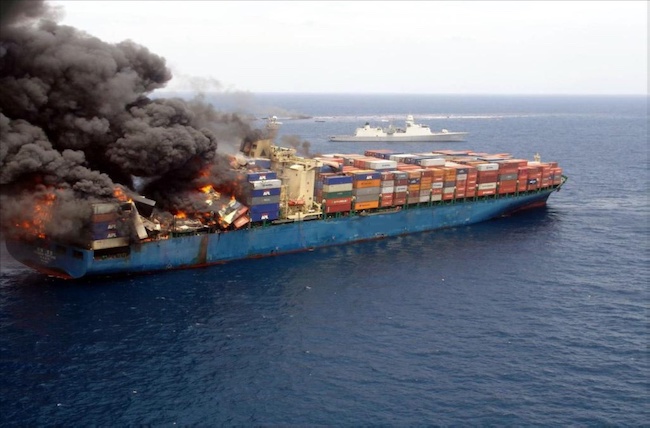

How ultra-large ships pose high salvage challenges

A theme of this year’s London International Shipping Week was container ships, coinciding with the first visit to Felixstowe of one of the new class of ultra-large 24,000-TEU vessels.
Even much smaller container ships pose a marine claims challenge when a voyage goes wrong. We are not infrequently reminded that Napoli, which was beached in English waters for salvage purposes, was a vessel of only 2,300 containers while Rena, which grounded off New Zealand, was carrying a mere 1,668.
In that case the wreck removal (still leaving the lower hull on the reef) took over two years at a cost of around US$400M.
Fire cases pose a particular problem as swift intervention is of the essence and locating a suitable port of refuge able and willing to provide space for salvage and post-salvage operations is of critical importance, and they are few and far between.
Steps have been taken internationally to improve co-operation in relation to ports of refuge (for example IMO Resolution A.949(23) and EU equivalents). But a shortage of work has led to a significant reduction in the number of international salvors perceived to be able to respond with the appropriate experience and expertise to a major incident.
Major container lines may prepare contingency plans and conduct simulated disaster scenarios in line with SMS requirements, but there is no real investment in the field by them or by salvors.
This is not helped by major lines chartering in tonnage and outsourcing slots to competitors, leading to multi-party stakeholding, consequent blurred lines in the chain of critical command and the risk of sub-optimal decision making.
So how has the legal and claims handling community responded to the challenge? Inevitably we lag behind, responding to cases with the tools at our disposal.
Ultimately, issues of liability, for example under the relevant contracts of carriage, will be fought if not resolved, with expert evidence pointing towards the cause of fire or grounding within the well-established framework of the Hague Visby Rules, for example.
Upfront, and by that I refer to casualty management, including salvage and general average (GA), a different dynamic often applies. Claims handling in that arena is as much down to co-operation as it is to the underlying legal regimes and supporting contracts. The latter are frequently in a relatively standard format.
The process of the unfolding situation is determined as much, if not more, by party identification and casualty information as by the small print.
To take one example, the voluntary provision of the bay planning file, container manifest and copy bills of lading demonstrating declared container contents within hours of a situation developing can transform the speed and agility not only of salvors and naval architects, but also GA adjusters tasked with the job of collecting GA and salvage security.
It hastens risk analysis, the identification of dangerous goods and a suitable fire-fighting plan as well as the expedition of undamaged consignments to destinations reducing wharf space, storage expenses and loss of market or deterioration claims.
The leading GA adjusters have developed systems whereby interested parties and their insurers can be notified, via an information portal if appropriate, of key developments in the salvage operation, of security requirements, box location, condition and help co-ordinate, with the carrier and attending surveyors, release for on-shipment. This is a mammoth task, but greatly supported by modern systems and communications.
Cargo interests often bear the brunt of a loss but are not shy to seek security themselves for their indemnity claims against the contractual carrier(s) or bailee.
This typically falls upon the P&I Club to arrange. However, carriers are quick to run a well-trodden path to the High Court to set up a limitation fund against which claims can be then lodged. This provides a single point in claims and a single fund from which claims may ultimately be paid.
Salvors have a direct claim against property interests and where Lloyd’s Open Form (LOF) is agreed, the shipowners’ obligation will be to secure ship and bunkers’ share of the eventual award only.
Security must be collected directly from cargo interests and owners are obliged not to release unsecured consignments.
This is problematic where cargo is uninsured, part damaged or of low value. The work-around under LOF is to apply to the arbitrator under cl.14 of the Lloyds Salvage Arbitration Clauses for consignments falling below a certain figure to be omitted from the salved fund and excused from liability for salvage.
The same approach can usefully be adopted in GA avoiding a disproportionate effort, with associated costs, to secure and make recoveries against high numbers of low value goods or boxes.
A frequent challenge emerges where lower value, uninsured or legally unrepresented cargo interests do not co-operate in the process.
The above clauses allow an arbitrator in those circumstances to make an award, taking into account the levels of settlement achieved where 75% or more of cargo by value have settled amicably.
Leading cargo and hull underwriters will meanwhile be seeking to settle the salvage claim in round figures sooner rather than later. Nor do they need to be too concerned about identifying precise contributory values in so doing. This is because salvage falls usually within the contractually applicable GA regime under the York Antwerp Rules and all stakeholder contributions will eventually be re-adjusted in GA with greater precision. Meanwhile under English law at least, the adjustment of GA and questions of fault are kept separate.
There are of course numerous further challenges and matters do not always proceed smoothly. Nonetheless, if I can be permitted to ring the praises during LISW of what is known in the market as “English law and practice”, I shall do so without shyness as, in general, we get the job done.
https://www.rivieramm.com/opinion/how-ultra-large-ships-pose-high-salvage-challenges-67581

